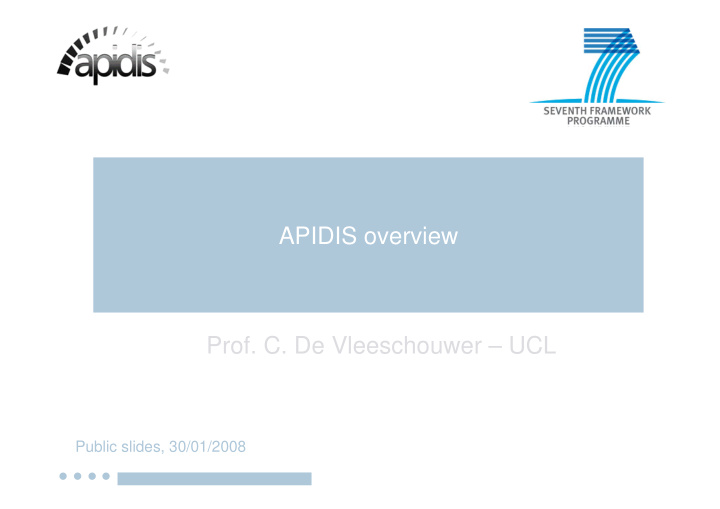



APIDIS overview Prof. C. De Vleeschouwer – UCL Public slides, 30/01/2008
Partners O Université catholique de Louvain, Belgium O Queen Mary University London, UK O Ecole Polytechnique Federale de Lausanne, Switzerland O Fundació Barcelona Media Universitat Pompeu Fabra, Spain O ACIC, Belgium O Mediapro, Spain
APIDIS vision & goal O Cost-efficient, and high resolution sensors. O Diversity and personalization of media access. → Need to link content acquisition and content consumers. O APIDIS objectives: • Autonomous acquisition and production of content. • Personalized summarization of events. • Interactive browsing/remixing solutions.
APIDIS vision & goal
APIDIS vision & goal
WP structure WP1 : Management WP2 : Requirements and specifications WP3 : Sensing network deployment WP7 : Integration and validation WP4 : Distributed feature extraction Videosurveillance Two application domains Sport event WP5 : Scene understanding Personalized Interactive Autonomous summarization access production Three action lines WP6 : Production and distribution WP8 : Dissemination and exploitation
Proof of concept trials O Automatic and personalized summarization of a video sequence, knowing salient segments. O Generation of high resolution images in any viewing direction based on an array of omnicams. O Distributed feature extraction and analysis for camera view selection.
Final demos O Sharing and remixing of content through intelligent browsing of manually pre-annotated content • for a production room, • using raw initial content exploited by local TV. O Interactive and semantically-driven access to video surveillance content • for operator or control rooms, • using indoor/outdoor site surveillance content. O Automatic generation of personalized summaries of content captured by distributed sensors • for Internet portals, • using autonomous distributed sensing.
Surveillance & Production room automatic summarization Test-bed architecture Off-line analysis MJPEG video Annotations Generic : Scene dependent time, activity Consensual User dep. measures.. Autonomous summarization using: Interest computation using: • • Annotations, Interest associated to content segments, • Context: scene semantics, • Context: user requirements, narration rules, and user interest. targeted platform, interactive process or not. Browsing facilities GUI
Role of partners Distributed sensing. MP D 3.1 and 4.1 Storage of representative samples and manual annotation of their Software for automatic Software for intelligent * salient segments. acquisition of content ACIC content manipulation D 3.2 and 5.1 intelligence* Distributed audio- Converting visual features omni-directional extraction and images into tracking. planar ones. QMUL EPFL D 4.2, 4.3 and 4.4 D 3.3 User-centered requirements Camera view Event Semantically- Interactive + assessment and display detection and meaningful access to BM parameters video segment summarization intelligent D 2.1, 2.2, 2.3 relevance relevance of content. content. D 6.3 UCL UCL UCL BM D 5.3 D 5.2 D 6.2 D 6.4 Test-bed for autonomous creation Proof-of-concept Test-bed for personalized access to of multi-view and semantically- multi-view and semantically- trials and final augmented content. augmented content demos ACIC ACIC MP D 6.1 D 6.1 D 7.1, 7.2, 7.3 * ‘Intelligence’ refers to knowledge about the semantic relevance of content segments, i.e. to salient segments definition.
Time table
Test-bed incremental development
Short term objectives O Management: project handbook, dissemination, IPR rules. O User group consultation: requirements and production rules. O User cases and corresponding architecture. O Content acquisition and storage. O Development environment: release of test-bed v1.
Recommend
More recommend